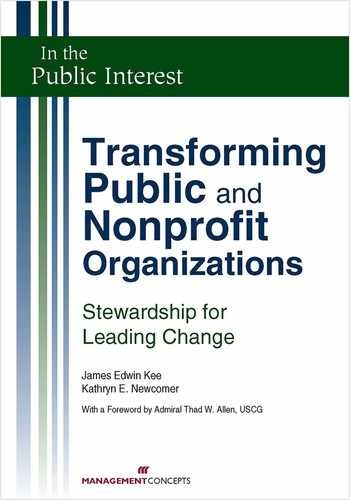Book Description In the public and nonprofit arenas, leaders face the unique challenge of protecting the public interest while implementing organizational change initiatives. To succeed, these leaders must build organizations that are “change-centric,” carefully weigh and prepare for the risks of change, and develop a change-oriented leadership style that authors Kee and Newcomer call transformational stewardship. Show and hide more
Table of Contents
Cover Title Page Copyright Page About the Authors Dedication Contents Foreword Preface Acknowledgments PART I: The Challenges for Leaders Chapter One: The Change Imperative What Is “Change in the Public Interest”? Evolving Modes of Service Delivery Challenges to Ensuring Public Accountability Other Pressures for Change in Public and Nonprofit Organizations The Challenge for Leaders The Responsibilities of Transformational Stewards Practical Tips for the Change Leader Suggested Readings on the Change Imperative Chapter Two: Transformational Stewardship in the Public Interest Taxonomies and Theories of Change Leadership Transformational Stewardship: Attributes of Change-Centric Leaders Evidence from the Case Studies Transformational Stewardship: A Balancing Act Practical Tips for the Change Leader Suggested Readings on Transformational Stewardship Chapter Three: A Model for Leading Change Initiatives Change Leadership Responsibilities A Model for Leading Change in the Public Interest Relationships among Risk Factors Implications for Change Leaders Practical Tips for the Change Leader General Readings on Change in the Public Interest Suggested Readings on Leadership Chapter Four: Case Studies of Transforming Public and Nonprofit Organizations Fairfax County Human Services Management Transformation Integrated Deepwater System: The Coast Guard Transformation Strategy Transforming the Veterans Health Administration Strategizing and Planning for Implementation of the REAL ID Act of 2005 New Leadership at N Street Village Transformation of Hillel Lessons Learned from the Case Studies Implications for Change Leaders Practical Tips for the Change Leader Suggested Readings for Case Studies PART II: Key Leadership Change Processes Chapter Five: Communicating and Collaborating with Stakeholders The Scope of Stakeholder Interests Collaboration Stakeholder Analysis Fostering Communication and Collaboration Developing Trust among Stakeholders Illustrations from the Case Studies Promoting a Shared Vision Practical Tips for the Change Leader Suggested Readings on Stakeholders Chapter Six: Creating a Change-Centric Culture Understanding Organizational Culture Developing Strategies for Changing the Culture Illustrations from the Case Studies Implications for Change Leaders Practical Tips for the Change Leader Suggested Readings on Organizational Culture Chapter Seven: Building Change Implementation Mechanisms Strategic Planning and Management Change Structures Organizational Learning Illustrations from the Case Studies Implications for Change Leaders Practical Tips for the Change Leader Suggested Readings on Change Implementation Mechanisms Chapter Eight: Measuring Change Performance Using Performance Measurement to Facilitate Change Efforts Illustrations from the Case Studies Implications for Change Leaders Practical Tips for the Change Leader Suggested Readings on Performance Measurement Chapter Nine: Leadership in Emergency Management Networks by Ron Carlee Response in a Multi-Organizational Environment Networks and Organizational Change What Doesn’t Work Complex Solutions for Complex Problems Implications for Change Leaders Practical Tips for the Change Leader Suggested Readings on Emergency Management Networks PART III: A Vision for the Future Chapter Ten: Developing Transformational Stewards Leadership Development for Transformational Stewards The Transformational Stewardship Development Path Implications for Change Leaders Practical Tips for the Change Leader Suggested Readings on Developing Transformational Stewards Chapter Eleven: Final Thoughts: An Invitation to Change Where to Start? Effective Stewardship in the Public Interest Change Is Possible—If Leaders and Organizations Are Prepared Appendix A: Leadership Change-Risk Diagnostic Instrument Appendix B: Transformational Stewardship 360-degree Assessment References and Further Reading Index
